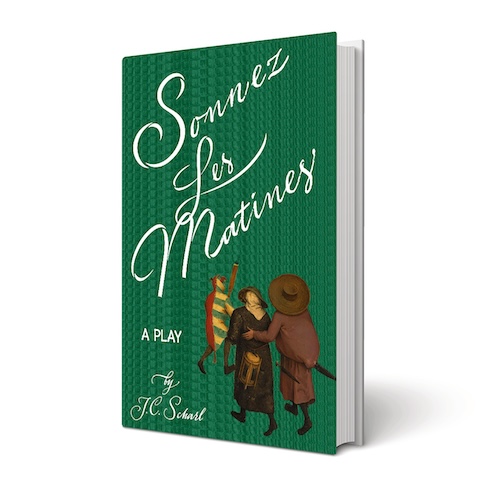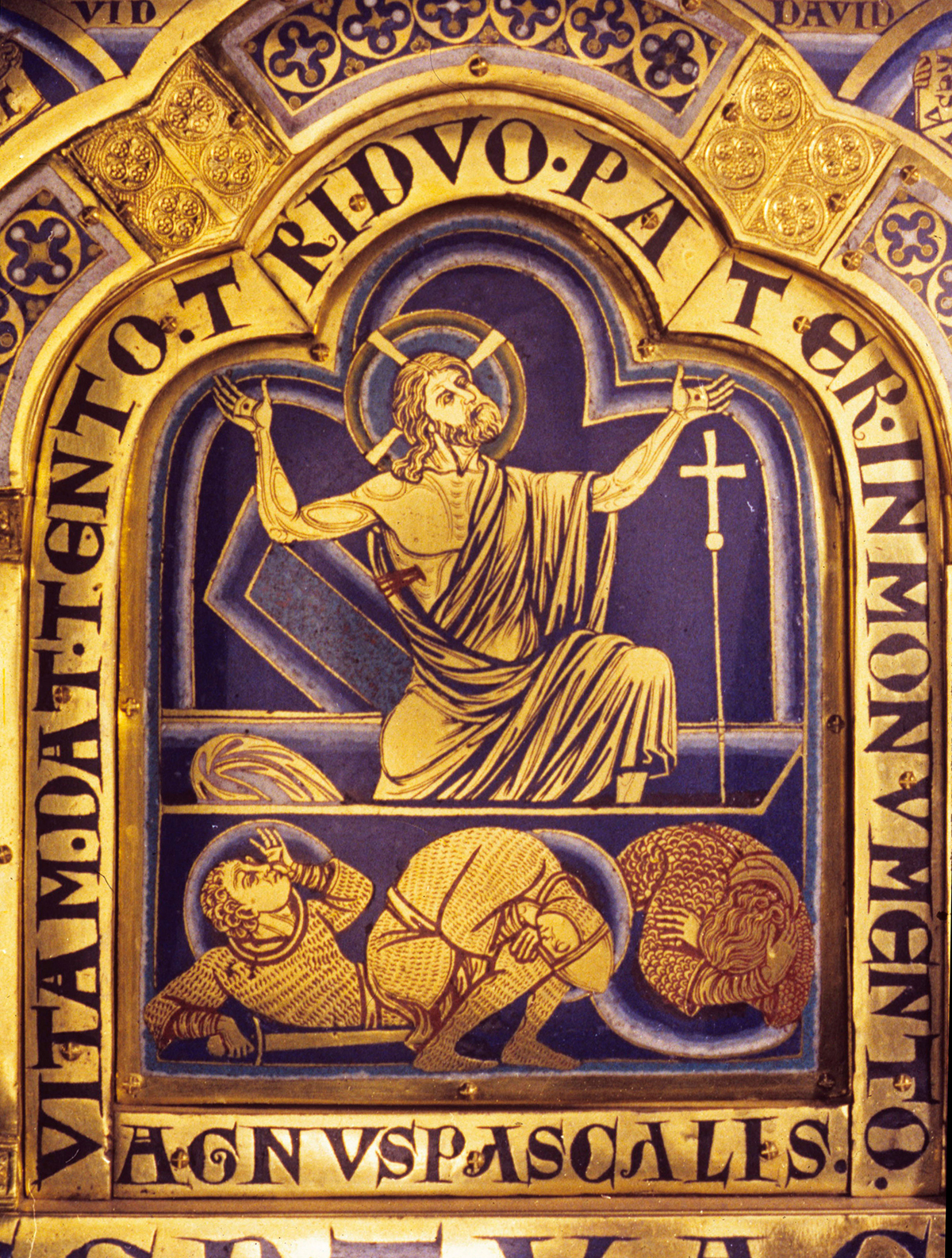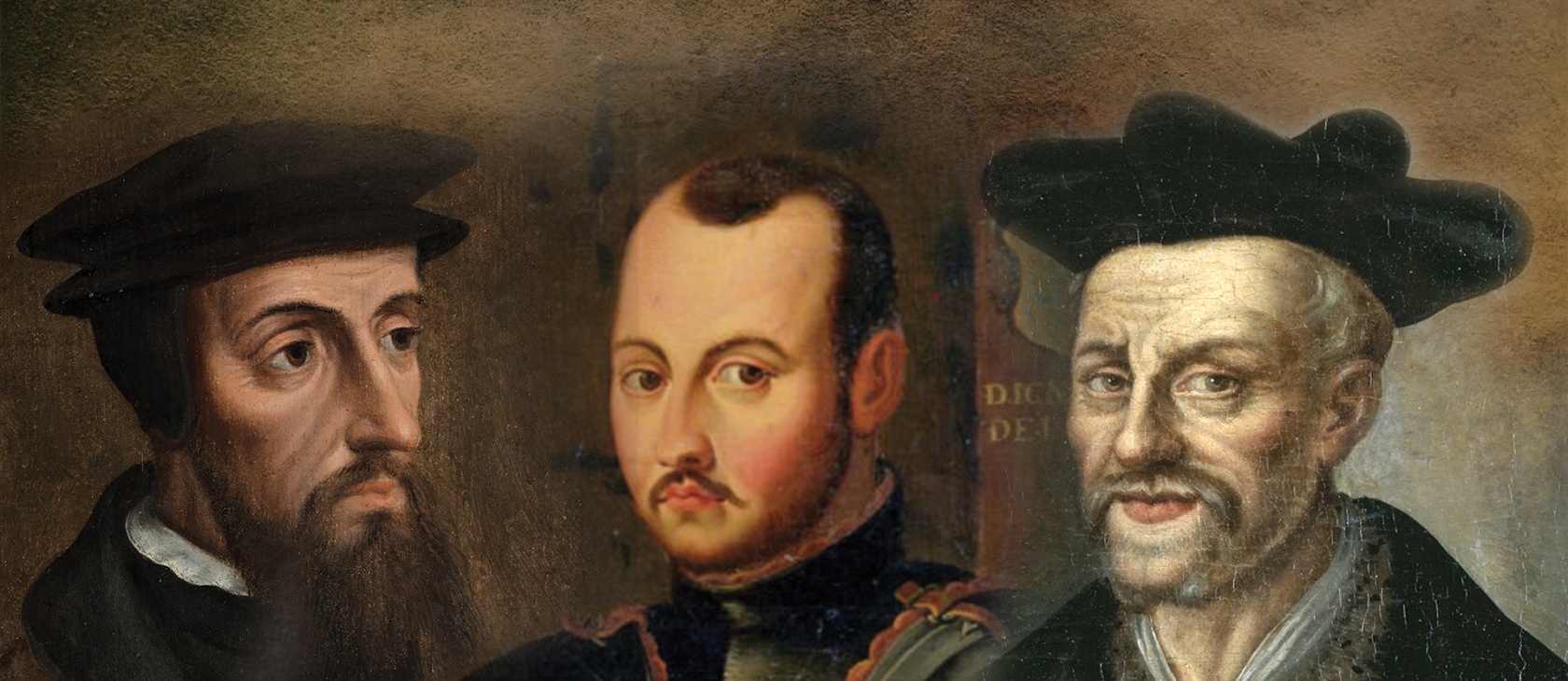Transformative is a tired word, maybe, for the kind of thing art does, and not really the right word. When we say that we’re changed by a story, or a poem, or a play, what we mean is that we’re made in some way more aware, awake, alive. Good art doesn’t pretend to change the world: not from something into something else. We simply know more clearly what’s real and who we are in that reality. Like children in a fairy tale, we return from our imagination’s adventure changed, but only into something more truly like ourselves.
Gathered around a murder victim are the father of Calvinism, the founder of the Jesuits, and the man who inspired the epithet Rabelaisian. Father Brown was never this interesting.

By Jane Clark Scharl
(Wiseblood Books, 2023)
Jane Clark Scharl’s remarkable play, Sonnez Les Matines, engages this paradox of imaginative renewal as a Christian vision for art by invoking the particular paradox of liturgical time as a frame for dramatic action. Secular time moves inexorably forward, a linear sequence of discrete days. But for the Christian, the year is a story, unified, completed, accomplished in the fact of the Resurrection, though it repeats itself endlessly until the end of time. Because we inhabit this world of time and change, we have to wait for the seasons to swing around again in their sequential course. Caught in time, changed by it, older every year, we enter each mystery as it comes and, if we allow its grace to work on us, are restored anew to ourselves. Only by measuring and experiencing time in this way, trusting in its cyclical form, can we begin to imagine eternity and ourselves in it.
This tension between linear and cyclical understandings of time finds a reflection in the playwright’s decision to set her drama in verse, not prose. Throughout the play, the poetic line, with its breaks, juxtaposes itself against the forward impulse of the characters’ utterances. Where a sentence says, I need to complete my thought, the line says, Whatever else is going on, I am complete. Where in secular time we speak of cause and effect, action and consequence, one thing following and completing another in sequence, liturgical time points us to the renewal of all things as a thing already accomplished. Inhabiting physical bodies in a temporal world, we experience this fait accompli in fragments, often messily. Yet, if we are Christian, we believe with St. Paul in his epistle to the Colossians that Christ “holds all creation together in himself.”
For the law student Jean Cauvin, the world in its fallenness is a hopelessly defiled form.
This understanding of reality is what holds together the world of Scharl’s play. Sonnez Les Matines happens in a historical moment simultaneously specific and ambiguous: the brief hours between the ringing of the bells for Vespers and again for Matins, but all we know beyond that is that it’s “sometime in the 1520s.” Martin Luther has already nailed his Ninety-Five Theses to the door of Wittenberg Cathedral. The Christian world is in upheaval. But in the play’s smaller world, with its compressed time, all that matters is that at the last gasp of Carnival, in a city both beautiful and squalid, three friends are complicit in a crime.
The crime is a murder, committed before the play’s action opens. The stabbing of a young woman in a fetid alleyway is the original sin with which Scharl’s trinity of characters must grapple. But the problem the play itself confronts isn’t the problem of sin. That problem, as the drama makes clear, is one for theologians, a problem to which systems of theology strive to make consistent answers. The play’s central problem, on the other hand, is the problem of the Christian artist: how to tell a story that points to a perfect God, in eternity, without compromising any truth in its representation of a fallen world.
For the law student Jean Cauvin, whom we know better as John Calvin, the world in its fallenness is a hopelessly defiled form. Jean mistrusts all its material forms, even the elements of the Eucharist: “sometimes I wonder just / what is meant by the body / and what signifies the blood.” He doesn’t ask what these elements mean, but what signifies them, what gives them meaning, when they belong to a world riven from its maker. Signaling his sense of alienation from Christ, the eternal Logos, Jean mistrusts even the verse forms that are his language, lapsing in and out of blank verse and soliloquizing in blocks of prose. He mistrusts, too, the renewal implicit in liturgical time. “All these trails,” he declares, “that lead out from the hearts and minds of men / lead only to one place: death.” The guilt he telegraphs as a response to the murdered girl is an existential guilt. Trapped in a defiled world with its remorseless time, he doubts his own salvation. At enmity even with his own body, which “flaps” around him like an ill-fitting cloak, and so at enmity with all the embodied-ness of creation, he believes that his only hope lies not in the possibility of change—in his universe there is no change—but in discovering, on the day of resurrection, that by the luck of some cosmic draw he hasn’t been, after all, the damned soul he fears he is.

The young Ignatius of Loyola, soldier turned theology student, has lost his heirloom knife. This knife of the Loyolas, beautifully wrought, “reveals God’s gleaming nature.” Discovering the knife beside the murdered woman’s body, sullied with her blood, Ignatius asks, “Do we leave no device of God unstained?” Device here could mean implement, or it could mean method. Either way, in Ignatius’ view of reality, as in Jean’s, the problem is a fundamental divide between God’s purposes and those of his creation. Where Jean views redemption as a matter wholly of God’s choice, Ignatius believes in human agency, the capacity for change. The bloodstained blade may be wiped and polished. The sinner may seek confession. This is the burden of Ignatius’ final speech. The Matins bells herald the end of Carnival, with all its sins of the flesh—and not a moment too soon. “The bells / call us to confession, now, / before the feast is ended.” What has been done in Carnival will be undone—must be undone—in the penances of Lent. For Ignatius, this is the story the Christian year tells.
In a lesser imagining, this play would involve two allegorical characters, not three. The Calvinist and the Catholic, dialectically opposed, would argue, and one or the other of them would win all the arguments. Too often, that’s precisely what Christian attempts at art turn out to be: a thinly fictionalized apologetics exercise, whose whole point is that one thing is wrong and another is right. Instead, Jane Scharl has imagined these two seemingly opposed characters as united in the limits of their vision. “Should I be ashamed,” asks Ignatius in scene 2, “to seek to change my nature?” Jean exhorts him to despair of his capacity to “turn this ruin / of a man, a bodied thing, to good.” But, counters Ignatius, though God is unchanging, and we can’t say “we are free in some way He is not,” God himself took a body, lived in it, died in it, raised it from the dead and took it back into the Trinity. “Do you say God changed?” Jean flashes back at him. Ignatius’ reply: “I don’t say that. But it does not seem / He stayed the same.”

Though their theological systems oppose each other superficially, it’s telling that this exchange plays out, for both speakers, in blank verse. Even in disagreement, on some deep level they speak the same language. Each character, in his own way, believes that created things—the body, chiefly—have been made by sin fundamentally alien to their creator. What they try to reconcile, by some system of rational thought, is the reality of a redemptive God, a Word made flesh, with the utter alienation of the material world.
Where they both fall short is in failing to imagine, as the most real reality, God’s existence outside time. The impulse by which Jean imagines fate as a ball of yarn being wound up, while Ignatius imagines it as embroidery on a blank sheet, is the impulse to say, First this happened, then that happened. Both conceptualize salvation as a linear, sequential narrative, with more or less “give” in its unspooling. What they don’t envision is an entire extratemporal economy. Both seek to explain, rationally, something eternal and mysterious. Both, ultimately, fail to imagine.
Enter François Rabelais, the necessary third person of this human trinity and the play’s real hero, not least because his presence disrupts the limited and limiting theological dialectic. Running, covered with blood, a total-body wallower in the mess and chaos of human life, he erupts onto the stage. Fastidious Jean remarks that the blood on François’ clothing “burns,” as if already the inevitable hellfire were starting to consume him. “A stained hood is one slip from a sainthood,” François fires back. Like all his jokes, this one is serious, a statement of faith. “The resurrection of the body” or “the resurrection of the bawdy?” They both sound the same. Why would they not mean the same? François is the one character who trusts the forms of this world to be both what they appear and more than what they appear. Of the three characters, he speaks consistently in meter and rhyme, trusting the formal shape to hold the creation of his language, sacred and profane, together in itself.
The historical Rabelais understood timelessness in terms of the body’s elemental cycles.
Outrageous as he appears, François alone trusts that reality is sacramental, more than the sum of its mangled material parts. Even the all-too-human blood that marks his clothes has a sacramental character, having flowed from a body that, for all the marks which time and experience have left on it, still bears the image of God. Looking on the naked body of the murdered woman, François alone of the three perceives her in her dignity. He knows her name: Manon, a diminutive of Mary, the Mother of God. In his gaze, this Mary’s bodily perfection lies in the identifying changes that sin and time have wrought, the marks of childbirth, the story her body tells, even in death.
Looking on her death, François perceives her life. She has not ceased to be a person with a name. The historical Rabelais, as the critic Mikhail Bakhtin has said, understood timelessness in terms of the body’s elemental cycles, chiefly the cycles of eating and defecating, and of sex. In Scharl’s Christian imagination, this paradox becomes the paradox of the “Happy Fault,” in which both fall and redemption form an entire, holy reality, clear in the eye of God. That eye does not perceive the fallen Manon apart from the sinless Mary, but even as it sees them distinctly, makes a unity of them.
The work of Christian art, as François’ character suggests, is to strive toward imagining that vision. Its trajectory doesn’t move from problem to resolution, from conflict to reconciliation, from ignorance to understanding, from sin to grace. Those moves aren’t what make art Christian. They might not even be what make it art. As this play closes, it’s hard to say that any one of the characters knows something he didn’t know before. Has he been transformed in any way, other than to grow a few hours older? Again, it’s hard to say. Each man has articulated who he is and what kind of world he thinks he lives in. Perhaps he knows himself better for having done so. And perhaps that’s all he needs to know.
But François has the last word. As the Matins bells ring, Jean abandons his friends in the muck, to seek the “terror” of grace for himself. Ignatius thinks of confession, where he hopes to leave his muck behind. Left alone, François declares, “In the muck’s the stuff / of ourselves.” The fallen flesh is not God’s enemy, or our own. “The world is ours,” he says—all of it, the mess, the chaos, the death, held together mysteriously by its maker—“ours, to save, or to throw away.”








